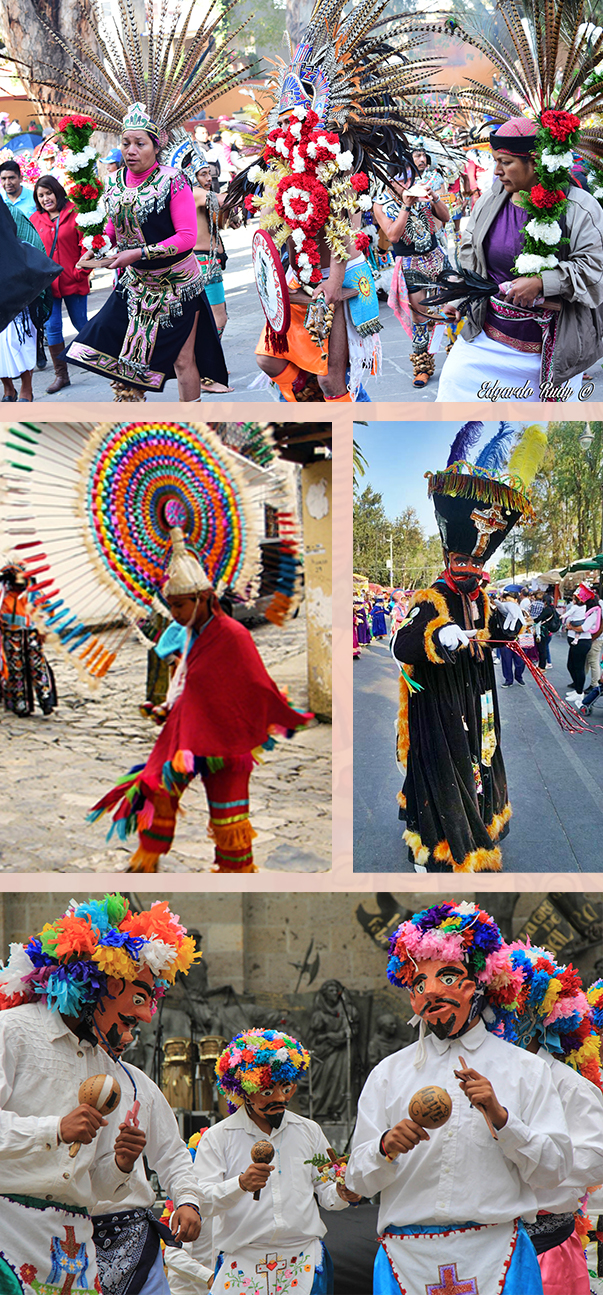Baile Folklorico
Central Mexico

Queretaro
The Concheros dance is also known as Apaches, Indios and Chichimecas. It is a ritual dance that likely developed after 1522 as a means of preserving some elements of pre Hispanic culture. Members of these dance troupes are part of formal societies and unlike some other groups admit women. These troupes perform at annual festival mostly in honor of patron saints—especially in the Villa de Guadalupe, Amecameca, Chalma and Los Remedios. These are located north, east, south, and west of Mexico City, a remnant of the importance of the cardinal directions to indigenous people. Dancers dress in indigenous style garb that can include loincloths, feathered headdresses body paint and more. They are accompanied by indigenous drums, flutes and small lutes made from armadillo shells (showing European influence). The symbolism and most of the steps are indigenous.
Mexico City
The Chinelos dance is derived from Carnival celebrations in what are now the south of Mexico City, Morelos and the State of Mexico. Since Carnival celebrations allow the wearing of masks for anonymity and behaviors not normally tolerated, a tradition arose for the indigenous to make fun of the Spanish elite and their dress through the dance. The word “chinelos” is derived from the Nahuatl word zineloquie, which means “disguised.” Chinelos dancers wear masks imitating the fair skin and beards of the Spanish along with elaborate dress and gloves. They are the best known Carnival dancers in Mexico with Morelos have the most groups. The Chinelo dancers are now a symbol of the state of Morelos, with the tradition increasing with more towns having dance troupes and it is possible to see troupes dancing at times other than Carnival. It is even possible to hire Chinelos dancers for special occasions.
The Danza de los Quetzales is performed in Puebla. The Huehues dance is performed by the Totonaca and is similar to the Quetzales dance. The headdress is smaller and less ostentatious.
The Ocho Vicios (Eight Vices) involves a number of dancers who represent the eight vices as well as an angel, a devil, a doctor and a priest. It involves a number of movements and spoken text. It is similar to a dance called the Siete Pecados (Seven Sins). Danza de los Tres Poderes (Dance of the Three Powers) is a moral tale similar to Siete pecados and Ocho vicios, which was introduced by the evangelizers to the indigenous. The main protagonists are the Archangel Michael, the Devil and a personification of death.
Segadores contains a number of characters, which includes the “captain” who pays his workers with money from the Mexican Revolution called “bilimbiques,” workers who become lazy and a woman who tends a store but in reality is a man. This dance is performed in some small communities in the State of Mexico.
Puebla
Acatlaxquis is an Otomi dance with pre Hispanic origins but uses a pan-style flute for accompaniment. The dancers form and arch with sugar cane stalks forming a kind of cupola. This dance is most often performed in the Pahuatlán municipality, along with the Voladores.[16] The Danza de los Arcos is done by men who carry large arches decorated with paper flowers and dance in rows. Their costumes are white with colorful sashes across the chest. It is mostly performed in Hidalgo, State of Mexico and Puebla.
Arrieros dancers wear white costumes, sometimes with leather chaps, and ride decoratively dressed donkeys. The dance proceeds as a procession and usually ends at a feast, which is central to the festival, with each arriero bringing a dish to share.
Caporales is a dance with men dressed as charros and used a small wooden bull.
Huehuenches or Huehues is a dance whose name is derived from the god Huehueteotl, the god of old age and of the New Fire. A better known similar dance is called the Dance of the Viejitos.
Negritos is danced in the Totonacapan region in Veracruz and Puebla. The Danza de los Quetzales is performed in Puebla. The Huehues dance is performed by the Totonaca and is similar to the Quetzales dance. The headdress is smaller and less ostentatious